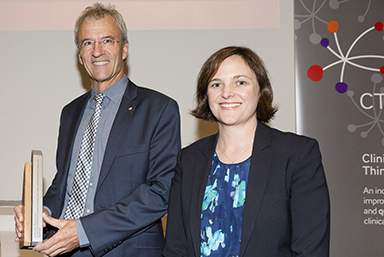Professor Jamie Cooper AO is Sir John Monash Distinguished Professor in the School of Public Health and Preventive Medicine at Monash University, and Senior Specialist in Intensive Care at The Alfred Hospital in Melbourne.
Professor Cooper's Project Grant focused on improving outcomes for patients with critical bleeding requiring massive transfusion.
This story is part of our 10 of the Best - thirteenth edition. 10 of the Best is an annual NHMRC publication, showcasing 10 NHMRC-funded health and medical research projects. See more 10 of the Best.
A massive blood transfusion is where a patient has critical bleeding requiring a large transfusion of blood. The Patient Blood Management Guidelines (2011), published by the National Blood Authority (NBA), acknowledges there is a lack of evidence underpinning massive blood transfusion policy in Australia.
According to the Australian Red Cross Lifeblood, 'massive transfusion' in adults is defined as the replacement of greater than one blood volume in 24 hours or greater than 50% of blood volume in 4 hours. Adult blood volume is approximately 70mL/kg.
To develop such a policy, robust evidence is needed to understand how much and what proportion of the 4 main blood components (plasma, red blood cells, white blood cells and platelets) to give patients when things go wrong.
Professor Cooper and his Partnership Project team from Monash University established a network of hospitals, using patient data to fill the missing gaps in the evidence base for massive blood transfusion policy.

From this, they created the Massive Transfusion Registry (MTR).
'We collected data from 5,655 patients requiring massive blood transfusions from 39 hospitals across Australia and New Zealand. Not only was the registry able to record information about the amount of blood lost, amount and types of blood that was administered during transfusions, and patient outcome, but it also collected patient data,' Professor Cooper said.
'This was crucial to the success of the MTR. For the first time, patient data was captured alongside treatment and outcome data, it was like connecting the dots between patient treatment and outcomes.
Blood transfusions are not a one-size-fits-all procedure. So, having this patient data really filled in the blanks and allowed us to build a framework for effective and efficient blood transfusion policy.
There is no national standard that governs how hospitals should record and store their treatment and patient outcome data, which proved challenging when creating consistent and standardized data for the MTR, Professor Cooper said.
The success of the Massive Transfusion Registry contributed to the establishment of the National Transfusion Dataset (NTD).
The NTD is bigger than the MTR in both size and scope and is now capturing information from all blood transfusions. The NTD has received funding support from several stakeholders, including Australia's National Blood Authority, the Victorian Department of Health and Human Services and the New Zealand Blood Service.
Next steps
The good news is that the information already collected by the MTR is being used to inform an update to the NBA's Patient Blood Management Guidelines (due early 2022), and the NTD will continue to collect patient treatment and outcome data in perpetuity, continuing to inform updates to best practice transfusion policy around the country.
Acknowledgements
Professor Jamie Cooper's Partnership Project was funded in partnership with the Australian Red Cross Lifeblood, the New Zealand Blood Service, the National Blood Authority, Victorian Department of Health, CSL Behring and St John of God Pathology.
CIA
Professor Jamie Cooper AO
Institution
Monash University
Title
Improving outcomes for patients with critical bleeding requiring massive transfusion
Team members
Associate Professor Zoe McQuilten
Professor Erica Wood
Professor Peter Cameron
Professor James Isbister
Professor Craig French
Professor Simon Stanworth
Professor Claire McLintock
Dr Amanda Zatta
Dr Anna Barker
Associate Professor Rosemary Sparrow
Mrs Helen Haysom
Dr Cameron Wellard
Mr Neil Waters
Grant information
$877,787
2014-2017
Partnership Project